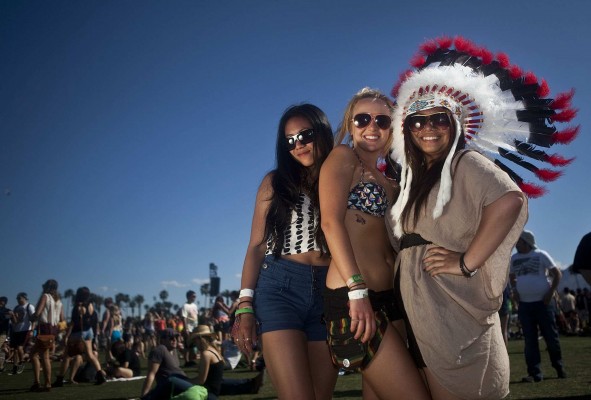My Culture is Not Your Fashion Accessory
MCT
An example of cultural appropriation is the Coachella music festival in Indio, California. (Arkasha Stevenson/Los Angeles Times/MCT)
April 28, 2015
With music festival season in full swing, it’s no secret that eager attendees are painstakingly crafting their trendiest, artsiest, most eye-catching outfits. Since festivals like Coachella, Lollapalooza and Bonnaroo have more or less transformed into fashion shows rather than concerts, chic ensembles are of the utmost importance. Any articles or accessories that will help music and fashion aficionados stand out as the coolest non-celebrities at the festival are fair game, including poached elements from other cultures. A pressing issue for social justice crusaders, cultural appropriation has recently popped up in the news to call out white women who are suddenly sporting Indian bindis and Native American headdresses.
A Free People-wearing girl with an Om tattoo travels to India on her copycat spiritual “Eat, Pray, Love” quest and discovers this other, exotic culture. She brings the “cool” parts of it back but leaves the oppression of the cultures from which she is stealing on the other side of the world. She traipses around in her new colorful clothing and jewelry, expressing how much better she feels now that her chakras are so aligned. Her newest Instagram selfie flaunts tags like #namaste #om #aura. This is a common example of cultural appropriation, or taking something from a typically oppressed, non-white culture and using it out of context to enhance and exoticize the appropriator’s physical appearance or identity. This can include music, spiritual rituals, language or garb. In the case of clothing, including accessories, jewelry and religious wear, music festivals are the main culprits in promoting cultural appropriation.
Various clothing brands capitalize on the festival fashion craze by creating themed lookbooks to promote their own products, and inspire other festival-goers on how to dress for the weekend-long events. Many apparel companies like Free People, Urban Outfitters and LF have commercialized both Native American and Indian culture by incorporating pieces of religious or cultural significance into their lookbooks and rebranding them as exotic and trendy. Taken completely out of their original contexts, these pilfered pieces are often distorted or sometimes even desecrated. This is problematic for those who belong to the cultural and religious groups being mimicked – problematic particularly because young children, who are so easily influenced by the celebrities they look up to, see them appropriating these items and think this is acceptable.
Former Disney star and High School Musical sweetheart Vanessa Anne Hudgens is a repeat offender of culturally appropriating both Indian and Native American accessories to enhance her Coachella wardrobe. In 2013, her first faux-pas was wearing a leather headband across her forehead with several feathers sticking out on top. She followed this the next day by donning a sparkly bindi in the middle of her forehead, surrounded by smaller, rhinestone-esque jewels above her eyebrows. When pictures of Hudgens and others pop up all over BuzzFeed, preteens gaze in awe at how innovative, exotic and artsy the celebs are.
However, when I see these same BuzzFeed articles, I am appalled by the lack of respect and acknowledgment for the original culture. As an Indian woman, if I showed up somewhere wearing a bindi without a traditional Indian outfit on as well, everyone would stare at me and think the jeweled dot in the middle of my forehead was weird. But if some blonde haired, blue-eyed girl did the same thing, everyone would think she was the cutest thing and would compliment her for being so bold and exotic. Notions like these affected my self-esteem growing up because I was worried about expressing my culture for fear of being mocked. From an early age I realized that if I expressed myself in a unique way, it was met with judgmental stares, but my white peers would be met with praise. What is offensive when you are a person of color is not offensive if you are a white person. That is cultural appropriation, and that is not okay with me.











nandita sharma • Apr 7, 2016 at 11:08 am
Dear Alysha, besides being a person who belongs to a certain caste, community or a nationality first of all, we are humans. the world is ours and we are hear to make it a better place. What i am trying to say is that we should and have to share our culture to others to make them understand where we belong to. Our India is not just about beautiful girls or clothes but there is more of it which the world needs to know so that their way of viewing india gets changed. I hope you understand what i am trying to say.
Waiting for your reply, Nandita.
Jaime • Apr 30, 2015 at 7:19 pm
People are so sensitive. Imagine if white people of european ancestry complained every time someone non-european wore a suit.
How about saying, “hey, i know this isn’t your culture, but i’m glad you’re experimenting and trying on something that you wouldn’t usually.”